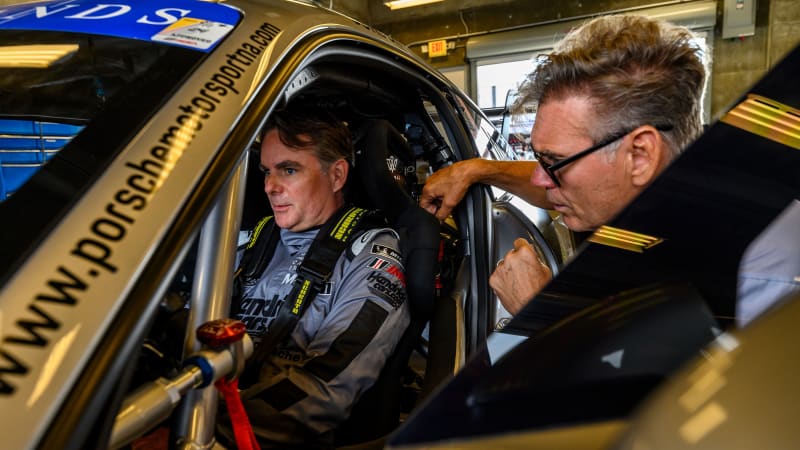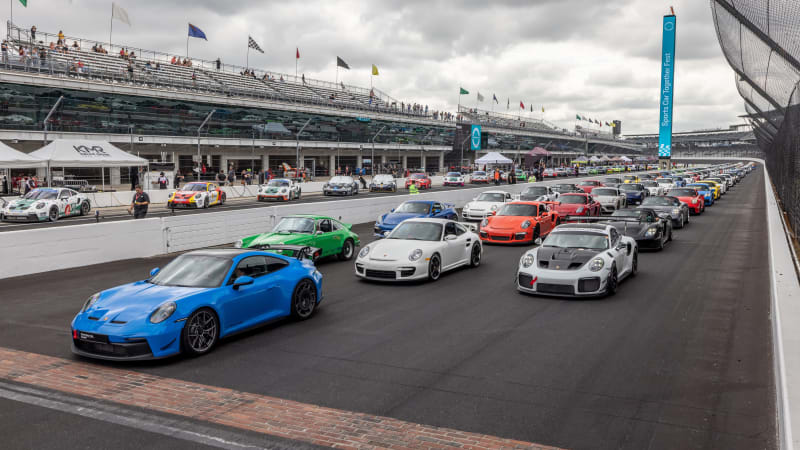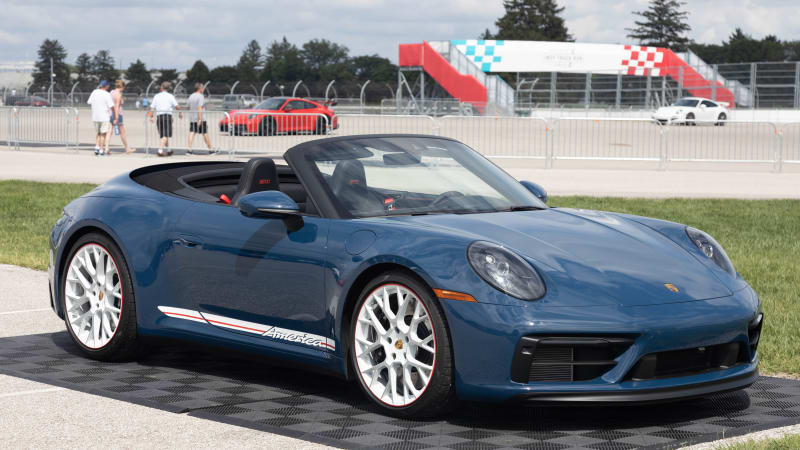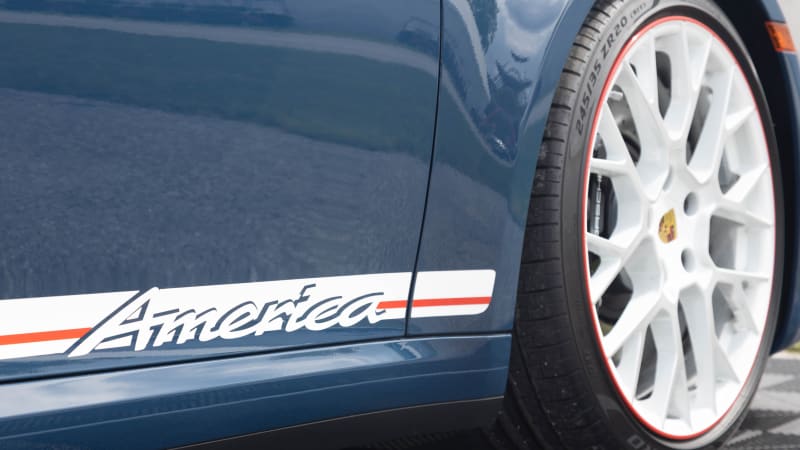Over Labor Day Weekend, Porsche held its second annual Sports Car Together Fest (SCTF) at the Indianapolis Motor Speedway. We happened to be nearby, so we swung by to check out an event we’d never heard of until a few weeks before. Reading about it on Porsche’s U.S. web site made us think it would be something like Rennsport Reunion for the Midwest. Turns out SCTF is just as much of a different kind of fun.
The fest
Tom Moore’s the man behind Dark Horse Motorsports, the motorsport consultant for Porsche Cars North America (PCNA) PR. “People love Rennsport Reunion, but that’s every three to four years,” he explained. “We wanted to gather people on those off years, and we didn’t want to just do a mini Rennsport, because that’s its own thing. We’ve maintained the motorsport history at Rennsport. Here [at SCTF], we’re doing the current look at what Porsche racing is for.”
In this case, that means gathering what Moore called “our Porsche motorsport pyramid.” That’s the range of enthusiast drivers from novice to hotshoes trying to get to top-tier endurance racing, “[starting] with the progression from Porsche Club of America track days up to the top of the ladder of one-make racing in North America,” the Carrera Cup North America, a series made up of nothing but the latest 500-horsepower 911 GT3 Cup cars.
The three days of racing action allowed almost any kind of Porsche owner interested in clipping apexes to compete around an Indianapolis Motor Speedway layout tweaked with an infield section. This year, that included ex-NASCAR star Jeff Gordon, coming out of retirement to reunite with his longtime NASCAR crew chief Ray Evernham for the top-class Cup races.

Evernham told us Gordon hasn’t raced in five years and he hasn’t been a crew chief in 22. On very short practice, Gordon finished in 14th in the Pro Class in the first Carrera Cup race of the weekend driving the #24 Hendrick Performance Group Porsche, and 11th in the second race. Afterward, he said, “I made a pass on the white flag lap. That made my whole weekend … I must say that yesterday, I thought ‘man, I am getting beat out here’ and I don’t like that. If I am going to be in an environment like this, I want to be competitive. But today turned the corner for me. So, I hope I get to do another one day.”
When we strolled the paddock after the event, exposed sheet metal proved “Rubbing is racing” is a thing in the Carrera Cup as well as NASCAR. Gordon didn’t shy away, but he kept it clean. Mark Kvamme, the AM Class winner in the first race, said, “I was around Gordon the whole race. It was a lot of fun. He is a very good driver, obviously, and he drove very fair too. He did an exceptional job.”
Speaking of kindness from other pilots, Pro Class driver Adam Adelson of Premier Racing normally puts #24 on the side of this GT3 Cup. His bio lists his first racing memory as “Watching Jeff Gordon race in NASCAR,” making quite the symmetry when he relinquished his usual number to Gordon for the weekend.
Evernham told us that, like Gordon, he hopes to come back as well. On the subject of Gordon getting beat out there, Evernham acknowledged the experience gap and said, “It’s like if you’re good at piano and someone gives you a guitar, you still gotta learn the instrument. I told him we can do it, we just need tools and time.”
Digital racing made its own statement in Indy. Porsche runs a global TAG Heuer Esports Supercup globally, this year, SCTF hosted the finals of the first-ever Porsche Esports Challenge USA hosted in Gran Turismo 7. Sixteen gamers won the feeder series’ to reach the finals in Indy. Randall Haywood claimed the cup in the final race and took home the the $15,000 top prize.

Competition is only half of the weekend, though. The other was about regular fun for families and Porsche owners. There were bus tours around the track, autograph sessions, displays of road cars and guided walkarounds of the newest 992-series road and race cars. There was the Pretty Cool 911 popsicle coupe, a GT Corral with more than 100 GT cars like the GT3, GT2, and 917, and parade laps for GT car owners. There was a restoration challenge and a Radwood meet just for Porsches. And on Saturday night, Porsche turned the giant infield board into a movie screen to show “Top Gun: Maverick.” For anyone who enjoys cars and racing, Sports Car Together Fest is a great way to spend a full, fun day or three.
Rennsport Reunion returns to WeatherTech Raceway Laguna Seca in Monterey next year, so 2023 will go without SCTF. But if you happen to find yourself around Indianapolis in the twilight of summer of 2024 and you’re up to do some laps around the Brickyard—in a car, or a bus, or on foot—or merely watch others do so while you enjoy Porsche ice cream, check out Sports Car Together Fest. Get a preview of what to expect in the captioned gallery of specialty cars and race cars in the gallery above, and the captioned gallery of on-track action and family festivities in the gallery below.
The 2023 Porsche 911 GTS Cabriolet America Edition

Everywhere you looked at SCTF, you saw Porsche Easter eggs. There was the Porsche Taycan Cross Turismo that American artist Sean Wotherspoon turned into a multicolored homage to his personal Volkswagen Golf Harlequin. There was the “Pretty Cool” 911 with the Porsche popsicle on top. This was Stuttgart’s take on an ice cream truck after the sports car maker collaborated with Chicago’s Pretty Cool ice cream on a run of five branded flavors in five Porsche colors.
And slightly less rare than those unique cars, there was this red, white, and blue one. Yes, the 2023 911 GTS Cabriolet America Edition debuted in June, and 114 of the 115 examples Porsche will build are sold out. But this egg had some surprise knowledge inside.
My inability to raise the engine cover to its highest position led to the arrival of Michael Tam, PCNA Product Manager for 911, Boxster, and Cayman models for the U.S. market. He gave us a walkaround and talked about the gestation and details throughout the droptop.
The key bit is that just before Tam’s arrival, an SCTF attendee walked up and, speaking to Moore, questioned whether the America Edition could be worth the money for a splash of paint and stickers. And let’s be honest, that’s the obvious take. But when Tam mentioned he’d spent two years on this one, we had to ask what took so long. It’s just paint and stickers, right?
“First, we need to propose [to Germany] that we have something good to celebrate,” he said. “Germany can only make so many special editions for all the countries around the world, and each country has to compete to see who has a better idea.”
This was news to us. Porsche’s done so well with what appears to be nothing more than paint samples and glue that it seems like execs come up with a special edition over lunch, run it on a dedicated line at Zuffenhausen in the afternoon, and sell the entire run before clocking out. Not the case, apparently.
“We said we really want to celebrate [the 356 America], they’d loved the idea.” Then came fighting for board approvals. Then came the workshopping. Then came more approvals. “We asked, what do we want the whole car to look like?” Tam said. One of the available colors on the 356 America was Azure Blue. When the team decided on that color, the modern version paint needed to be reformulated without no-no metals like lead, and taking the clear coat and paint shop processes into account.
“The Azure Blue alone took a year of the approval process,” he said, “because we painted three body-in-whites, then tested to make sure the paint looked good on the body-in-white before we actually painted that first car.”
Porschephiles blue with envy about this will be happy to know Azure Blue joins Porsche’s paint-to-sample program next year.
Many of the details are standard stuff, like the sill plates celebrating the 1952 and 1992 America Editions, and the special Pebble Gray and red stitching in the seats and instrument panel. Some are special details you might not notice at first look, like the black windshield frame intended to diminish the windshield, which is normally body color, for a more roadster-ish look.
Other details came from customer suggestions or noting what customers do to their Porsches. One of these on the America Edition makes a world first: Two-color model script on the rear bumper. Tam said some customers like to have their badges painted in contrasting colors, so Porsche’s done it for the first time ever from the factory.
But wait, there’s more—a second factory-stock world first on this car is the red numbers on the shift knob.
There are details you wouldn’t know unless you were deep into Porsche history. The 356 America Roadster was a commercial failure. It barely sold 20 units in its sole market, the U.S., and the coachbuilder for the aluminum bodies lost money on every shell, helping drive that company out of business. However, the America Roadster led to the 356 Speedster, which, putting it mildly, did quite well. Forty years later, perhaps hedging its bet, Porsche sold the 1992 911 America Edition around the world, calling it the “Turbo Look” Carrera in other markets.

And then there are details you wouldn’t know about unless you got a tour from the product manager or a knowledgeable salesman, like the three-color wheels. The rims feature a Guards Red stripe on the lip, polished silver faces, and white pockets, and all of it is painted by hand. Let’s say that again: Every one of the 460 wheels on the 115 cars to be sold in the U.S. and Canada is painted by hand. And we assume there will be a few spares in there as well.
Naturally, we asked if the product team had tried machines for this.
“Of course,” Tam replied. “We tried to machine the silver face, but we found it didn’t go very well because where the red and white meet is a very fine edge. The machines didn’t do it the way we wanted it.” In this case, robots couldn’t replicate the precision a 911 wheel demands, so Porsche called in the human artisan who “masks it out and paints each section individually.”
The wheels are also a throwback: Depending on how owners decked out their 1952 356 Americas, the roadsters might have had white painted centers, just like the wheel on this America. Tam said, “We were trying to evoke little of that without putting a hubcap on the car.” The effort involved in the wheels is what helped keep the production number down to 115 units—100 for America, 15 for Canada.
The SCTF attendee who’d made the comment about paint and stickers and worth had walked away before Tam gave his spiel. Would knowledge of two years of work behind each detail and hand-painted wheels have changed his mind? Who knows. But it expanded ours.
For anyone who’s now interested in taking one home, there’s one car left unclaimed. The only way to have a chance at getting it is to join the Porsche Club of America and enter the club raffle. Tam said, “If you’re a club member, pay $50, and enter the raffle.”
Which sounds about like what it takes to get just about any car nowadays. Except those other cars don’t sit on hand-painted wheels.
Related Video
